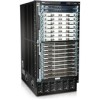Dell PowerConnect J-8216 Hardware Guide - Page 107
Calculating the J-EX8200 Switch Fiber-Optic Cable Power Budget
 |
View all Dell PowerConnect J-8216 manuals
Add to My Manuals
Save this manual to your list of manuals |
Page 107 highlights
Chapter 7: Planning Power Requirements NOTE: We recommend that you maintain N +1 or N+N power supplies in your switch at all times. Replace failed power supplies immediately to prevent unexpected failures. Power management raises a minor alarm if the number of online power supplies in your switch is less than the number required to maintain the configured power redundancy (N+1 or N+N). If the problem is not corrected in 5 minutes, a major alarm is issued. Power management raises a major alarm if the number of online power supplies in your switch is less than N power supplies. Power management provides power to line cards in priority order until power is exhausted. The remaining line cards are powered off. If a new line card is installed in an operational switch, power management does not power on the line card if the increased power demand exceeds the total available power, including redundant power. If redundant power is used to power on the line card, a minor alarm is raised, which becomes a major alarm in 5 minutes if the condition is not corrected. Related • AC Power Supply in a J-EX8200 Switch on page 39 Documentation • Understanding Power Management on J-EX Series Switches Calculating the J-EX8200 Switch Fiber-Optic Cable Power Budget Calculate the link's power budget when planning fiber-optic cable layout and distances to ensure that fiber-optic connections have sufficient power for correct operation. The power budget is the maximum amount of power the link can transmit. When you calculate the power budget, you use a worst-case analysis to provide a margin of error, even though all the parts of an actual system do not operate at the worst-case levels. To calculate the worst-case estimate for fiber-optic cable power budget (P ) for the B link: 1. Determine values for the link's minimum transmitter power (P ) and minimum receiver T sensitivity (P ). For example, here, (P ) and (P ) are measured in decibels, and R T R decibels are referred to one milliwatt (dBm). P = -15 dBm T P = -28 dBm R NOTE: See the specifications for your transmitter and receiver to find the minimum transmitter power and minimum receiver sensitivity. 2. Calculate the power budget (P ) by subtracting (P ) from (P ): B R T 91















